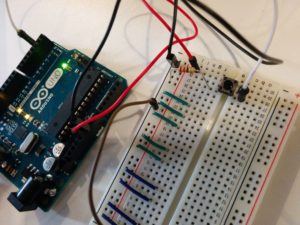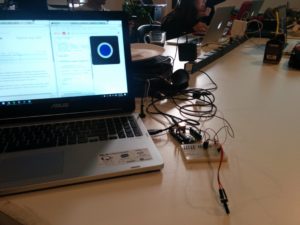We are starting to get towards the middle of the semester, and have added more foundational building blocks to the programming repertoire. This time around, it is working with objects and constructors. Getting used to “the Javascript way” has been a bit of a challenge, and I’m glad I get to practice the implementation even if I’m already familiar with the concepts.
This was also an opportunity to use p5’s sound library, which I have been very curious about. Getting my objects and constructors all set allowed me a lot of flexibility in terms of creation and playing around with ideas. I wanted bouncing balls that played sounds when they hit the ground, and the object oriented approach let me easily play around with their properties and behaviors, including the sonic ones.
In this sketch, you click to create a ball. The ball will fall and bounce, making a noise. Press keyboard buttons 1 through 4 to change the kind of ball you want to create.
http://alpha.editor.p5js.org/projects/SkcYoLKR
Lots of fun! I love sound interaction that is playful and a little unorthodox. I’m really impressed with p5’s implementation of it, and can’t wait to dig in more.
There were some conceptual questions I had to ask myself. Right now, the balls all more or less behave the same. They could easily be one soundBall class and then have their “type” passed to them to determine behavior. But I had the feeling that I might want to make their behavior drastically different from one another in the future, so I decided for now to make them all separate kinds of objects.
This made my displaying and updating routines in the main sketch a little repetitious. I was wondering if an elegant solution might be having an array of arrays, with each “second level” array hold all of each kind of ball. But then I was wondering if it is bad form to have arrays with mixed types of variables inside.
There were also some quirks in regards to getting the sound going, which might be out of the scope of the class for now but I will definitely want to pursue later. All in all, though, a fun time and whet my appetite for making more advanced objects and really working the sound library.
Synthesis
And then there was Synthesis! I’ve gone over this in my PComp blog as well, but will repost here as well.
This past week we had our “Synthesis” session: the combining of the things we have learned in Physical Computing and Computational Media. In short: getting our P5 sketches to talk to our Arduino. Fun stuff!
I was partnered with Chris Hall, who had an awesomely trippy sketch that we thought would be fun to control physically. Her original program triggered animation on clicking, and we managed to translate that to an Arduino button press.

We were pretty happy with ourselves, pressing away and showing off our work:
We are blowing minds on the floor!
Tom Igoe saw our work, complimented us… and promptly told us to add more. His advice to use p5’s split() function was key information, and saved us a lot of time in figuring out how to implement two inputs. Though even then there were some issues in formatting the serial communication coming out of the Arduino. At first I had done some string concatenation on the Arduino side in order to send out comma separated values, but it was getting turned into jibberish. Using individual Serial.print() commands, then ending everything with a Serial.println() seemed to do the trick. We were now able to press the button to start the animation, and then use a potentiometer to change the hue of the colors in the sketch.
